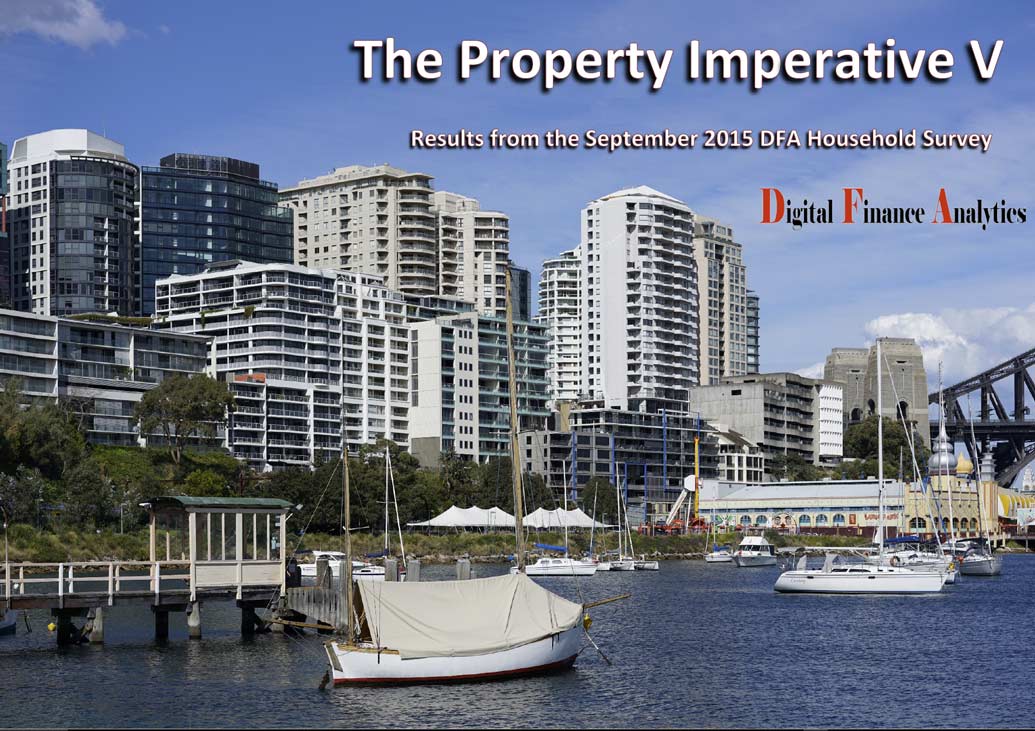The Property Imperative, Fifth Edition, published September 2015 is available free on request.
This report explores some of the factors in play in the Australian residential property market by looking at the activities of different household groups using our recent primary research, customer segmentation and other available data. It contains:
- results from the DFA Household Survey to September 2015
- a focus on underwriting standards and mortgage pricing
- an update of the DFA Household Finance Confidence Index
- a discussion of the impact of high house prices
 You can obtain a copy of the report, delivered via email here.
You can obtain a copy of the report, delivered via email here.
From the Introduction.
The Property Imperative is published twice each year, drawing data from our ongoing consumer surveys, research and blog. This edition dates from September 2015 and offers our latest perspectives on the ever-changing residential property sector.
We begin by describing the current state of the market by looking at the activities of different household groups using our recent primary research and other available data.
In this edition, we also look at current mortgage pricing dynamics and underwriting standards; update our household finance confidence index and discuss the impact of chronically high house prices over the longer term.
Residential property is in the cross-hairs of many players who wish to influence the economic, fiscal and social outcomes of Australia.
By way of context, the Australian residential property market of 9.53 million dwellings is currently valued at over $5.76 trillion and includes houses, semi-detached dwellings, townhouses, terrace houses, flats, units and apartments. In the past 10 years the total value has more than doubled. It is one of the most significant elements driving the economy, and as a result it is influenced by state and federal policy makers, the Reserve Bank (RBA), banking competition and regulation and other factors. Indeed the RBA is “banking” on property as a critical element in the current economic transition.
According to the RBA, as at July 2015, total housing loans were a record $1.48 trillion . There are more than 5.4 million housing loans outstanding with an average balance of about $243,000 . Approximately 61% of total loan stock is for owner occupied housing, while a record 39% is for investment purposes. Last month, more than half of new loans written were for investment purposes.
The relative proportion of investment loans leaped by nearly 2.5% to 38.9% thanks to a significant reclassification of loans by some lenders.
In addition, 39.7% of new loans issued were interest-only loans.
The RBA continues to highlight their concerns about potential excesses in the housing market . In addition Australian Prudential Regulation Authority (APRA) has been tightening regulation of the banks, in terms of supervision of lending standards, the imposition of speed limits on investment lending and has raised capital requirements for some banks . The latest RBA minutes indicates their view is these regulatory changes are slowing investment lending somewhat , though we observe that demand remains strong, and in absolute terms, borrowing rates are low.
The story of residential property is far from over!
Table of Contents:
1 Introduction 3
2 The Property Imperative – Winners and Losers 4
2.1 An Overview Of The Australian Residential Property Market 4
2.2 Home Price Trends 4
2.3 The Lending Environment 6
2.4 Bank Portfolio Analysis 9
2.5 Market Aggregate Demand 10
3 Segmentation Analysis 16
3.1 Want-to-Buys 16
3.2 First Timers 16
3.3 Refinancers 19
3.4 Holders 19
3.5 Up-Traders 20
3.6 Down-Traders 20
3.7 Solo Investors 21
3.8 Portfolio Investors 21
3.9 Super Investment Property 21
4 Special Feature – Current Mortgage Pricing Dynamics 24
4.1 Regulatory Context 24
4.2 Bank Reaction 25
4.3 Portfolio Implications 28
5 The DFA Household Finance Confidence Index 30
6 Who Benefits From High House Prices? 33
7 About DFA 35
8 Copyright and Terms of Use 36

9 thoughts on “Latest DFA Report – The Property Imperative 5 – Just Released”